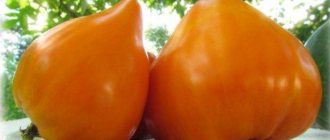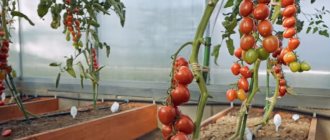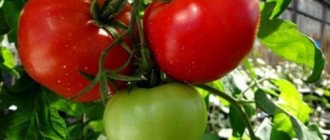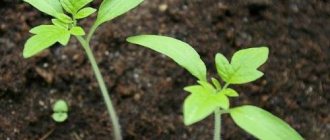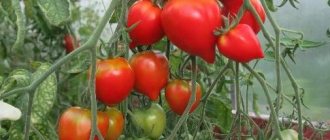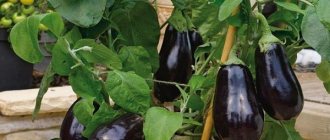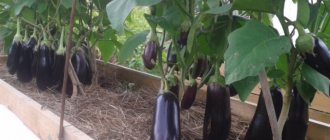Description of the eggplant variety Vera
The fruits are pear-shaped, elongated 15-20 cm and about 200 g
The Vera eggplant variety is early; it takes an average of 115 days for the first fruits to fully ripen. The bushes grow up to 75 cm or a maximum of 100 cm in greenhouse conditions. The leaves are medium-sized, green with a purple tint. There are notches along the edges of the sheet plate. The bushes are almost thornless.
The fruits are pear-shaped, elongated 15-20 cm and about 200 g. The color is dark purple. The peel is smooth, glossy, thin. The pulp is white, medium density, without voids. The taste is without bitterness, pleasant. The Vera variety of eggplant can be stewed, boiled, fried, baked. The harvest that is not consumed in the summer can be frozen or dried and used in the winter to prepare a variety of dishes.
Characteristics of eggplant Vera
Also check out these articles
- Drip irrigation system
- Rabbit Lop-eared ram
- How many square meters in one hectare
- Stone path for the garden. Why is this ideal?
Cross-sectional photo of Vera eggplants
The Vera variety of eggplant has its own special qualities that distinguish it from other varieties and hybrids.
- Early variety. Technical ripeness of fruits is observed in August or early September.
- The variety is suitable for growing in greenhouses and open ground.
- Productivity is average but stable. From a bush you get approximately 500-1000 g of fruit, and from a square meter, respectively, about 4 kg (depending on the density of plantings).
Important!
Dense planting does not ensure high yields. On the contrary, densely planted bushes have no way to develop and produce much less harvest.
- An adult plant is resistant to cold weather.
- Commercial quality 90-100%.
- Transportability at a high level.
Advantages and disadvantages
Among the positive aspects of the variety are noted:
- Early ripeness.
- Good adaptability to both open ground and greenhouses.
- High resistance to cold and temperature changes.
- Excellent fruit taste.
If all the recommendations were taken into account when growing and the care was correct, then in August Vera’s eggplant will certainly please you with a harvest. When they reach ripeness, eggplants need to be cut, because if you leave them in the garden, the skin will lose its gloss, the seeds will become coarse, and other fruits will not have the strength to set. The Vera variety is great for preparing many dishes and for preserving for the winter. In addition, its fruits are low-calorie and contain sufficient amounts of calcium, potassium, sodium, phosphorus, magnesium, vitamins B and C. Therefore, you can not only enjoy the taste of eggplant, but also benefit the entire body.
Sowing seedlings
Photo of growing seedlings in a greenhouse under film
You can sow Vera eggplant seeds directly into open ground only in the southern regions. But even there, gardeners often use seedlings to get the harvest much earlier. Seeds for seedlings are sown from the end of February until the first half of March. Sowing is carried out in a container with a diameter of about 8 cm. Trenches are made, seeds are sown in them, sprinkled with earth, sprinkled with water from a spray bottle on top and covered with film.
Important!
If the seeds are sown directly into the garden bed, then this should be done in April or May, when a stable temperature has established and the spring cold has passed.
The seeds will germinate in about 5-20 days, depending on conditions, soil, temperature, lighting. The type of seed is also important. If you buy them at the market (by weight), then the chance of friendly shoots is minimal, but if you buy them in a store, in bags, and even choose a good manufacturer, then shoots will appear earlier. After emergence of shoots, the film is removed. Before planting in open ground, approximately 2 months should pass from the day the seedlings appeared. During this time, the sprouts will become stronger and will be resistant to weather changes and diseases.
Photo of planting eggplant Vera in open ground
Growing in a greenhouse
In regions with cool summers, eggplants are planted not in open ground, but in unheated greenhouses or film shelters.
Features of growing eggplants in a greenhouse:
- “Valentina” eggplants are planted in greenhouses from approximately May 10 to May 20.
- The planting pattern is similar to open ground - 60x30 cm.
- The bushes are watered only with warm water 2 to 4 times a week.
- After watering, the soil must be loosened, trying not to damage the roots.
- It is recommended to mulch the soil.
- 3 weeks after planting, the plants are fed. The best option is to water the plantings with Kemira Universal solution. The solution is prepared by diluting 1 tbsp. l. drug in 10 liters of water. Watering rate is 500 ml per plant.
- Organic or mineral fertilizers are used for feeding. Recommended organics are wood ash, fermented solution of grass and weeds, diluted manure.
- When the ovaries appear, half are removed, leaving the largest ones. This will speed up the ripening of the fruits and make them larger.
- The greenhouse is regularly ventilated so that the eggplants do not “suffocate”. The "Valentina" variety is very resistant; it can withstand unfavorable conditions, including elevated temperatures. The bushes will retain the ovaries, but the fruits will grow small.
- In the greenhouse it is necessary to maintain optimal humidity - no more than 70%. If the greenhouse is damp, the pollen from the flowers will not be able to move in space, and the yield will drop.
Planting eggplant
We recommend reading our other articles
- Recipes for lecho with carrots
- Green grape varieties
- Beeswax
- How and what to feed ducklings from birth
It is advisable to plant Vera eggplants in fertile, light soil rich in organic matter. Therefore, starting in the fall, the area allocated for the crop is fertilized with manure, compost or humus. In the spring, the bed can be dug up again, loosened and covered with polyethylene so that the earth warms up as quickly as possible. The place should be illuminated and protected from strong winds.
Planting seedlings in greenhouses or open ground is carried out in May, when the ground has warmed up well to +14 degrees and the threat of return frosts has disappeared. For the sprouts, make holes at a distance of 30-35 cm, with 60-65 cm of free space between the rows.
There should be 60-65 cm of free space between the rows
Plant care
For proper development, bushes need not only proper planting or a good location. Care throughout growth also plays a significant role.
- Vera eggplants are watered regularly, right at the root, so that the earthen lump does not dry out. To do this, use warm water, which can be left in the sun. Before flowering, watering is carried out approximately once a week at the rate of 12 liters of water per square of planting. After flowering begins, watering is carried out every 3-4 days.
- During the entire growing season, the bushes are fed 3-5 times. Fertilizers for Vera eggplants should include nitrogen, potassium, calcium, magnesium, phosphorus, boron and manganese. But depending on the time of feeding, the concentration of certain substances will be different. So, at the beginning of the growing season you need more nitrogen, and at the end - phosphorus and potassium.
Vera eggplants are watered regularly, right at the root.
Interesting!
The optimal temperature for the development and fruiting of eggplants is +20...25 degrees. Prolonged heat (above +30 degrees) or prolonged cold spells slow down the growth and inhibit the development of the Vera eggplant variety. At this time, flowers and even ovaries on bushes may fall off.
- It is not necessary to tie up the plants, because they grow short, however, during fruiting, eggplants can pull branches to the ground!
- Form a bush with 3-5 stems. Up to 10 ovaries are usually left on each plant so that the load is not very heavy.
- All the stepsons that appear (and there are quite a few of them) need to be removed, just like the leaves growing below the first branch.
- Eggplants can suffer from blackleg and late blight. For prevention, plants and soil can be treated with special fungicides. But if the bush still gets sick, you need to remove it from the garden bed as quickly as possible so that the disease does not spread to other plants.
- Pests rarely attack the Vera variety. Most often you can find the Colorado potato beetle on leaves. It is worth using insecticides or simply collecting it by hand. Many gardeners plant marigolds or basil nearby; they repel this pest with their smell.
Diseases and pests
During the growing season, due to improper care, Vera's eggplant may suffer from various diseases. Most often, eliminating errors (normalizing watering, applying fertilizer, eliminating thickening) corrects the situation and restores normal development of the plant. But sometimes you have to resort to more radical methods. In addition to diseases, insects can harm eggplant. The most insidious of them is the Colorado potato beetle.
Recent Entries
5 working ways to use tar in the garden 7 indoor plants that help you get married even in adulthood Indoor plants that can bloom in trouble
Blackleg
Most often, this dangerous disease manifests itself at the stage of seedling development. But plants transplanted into open ground are not immune from this danger. The stem at the base begins to darken, becomes thinner and becomes covered with a grayish coating. The plant gradually fades. If the disease penetrates the roots, the bush will die. Ideal conditions for the development of the disease are high humidity, acidic soil, and temperature changes.
To prevent fungal infection, seeds are disinfected at the stage of preparation for sowing. You also need to remember that:
- before planting eggplants, acidic soils are alkalized;
- nitrogen-containing fertilizers can cause problems, so don’t get carried away with them;
- Crop rotation significantly reduces the risk of developing this disease.
If the black leg could not be prevented, it is necessary to urgently remove the affected plants along with the root ball and destroy them. Treat the well with a 1% solution of copper sulfate, or one of the biological products - Alirin, Glyocladin, Gamair or Trichocin. Use according to instructions.
Blackleg can affect eggplant at the seedling stage
Late blight
This is the most common disease of nightshades. The leaves are affected first. Brownish-red spots appear on them, bordered by a light green stripe. Then the disease invades the stems and fruits. Depending on weather conditions, late blight manifests itself in different ways. In dry weather, the affected leaves dry out and quickly fall off. When wet, they become covered on the underside with a whitish coating. Brownish-brown blurry spots appear on the peduncles with fruits. Morning fogs, high humidity, dense plantings and temperature fluctuations are the most favorable factors for the development of the disease.
To combat late blight, the following drugs are used:
- Quadris;
- Consento;
- Antracol;
- solution of 1% Bordeaux mixture;
- 0.2% solution of copper sulfate.
For prevention purposes, agricultural practices must be followed. Traditional methods also come to the rescue.
- After harvesting, all plant debris should be collected from the garden bed. If late blight is noticed on tomatoes or potatoes, treat the eggplants with garlic infusion - chop 200 g of the product, add 3 liters of water and leave for several days. Before use, strain the tincture and dilute with clean water 1:1;
- You can spray the bushes with milk diluted with water in a 1:1 ratio.
Late blight affects eggplant leaves
Colorado beetle
This pest is familiar to many gardeners. The most dangerous are the larvae of the Colorado potato beetle. They are the ones who are capable of destroying foliage, flowers and ovary in the blink of an eye, leaving only the trunk of the eggplant. Of course, you can forget about the harvest.
You can fight the Colorado potato beetle in different ways. Very often, beetles are collected by hand, but, as a rule, these actions do not bring the desired result. It is best to turn to traditional methods or purchase chemicals in specialized stores. In addition, there are plants whose smell is unpleasant to the pest.
Folk remedies
Folk remedies are effective when the Colorado potato beetle is just beginning to appear and its quantity is too small.
- Add a glass of chopped garlic to 10 liters of water, leave for 4 days, filter and dissolve a little laundry soap in the infusion.
- A decoction of horsetail and dandelion. Chopped plants (1 glass of each) are poured into 10 liters of boiling water and left for 2 days.
- 50 g of hot pepper is poured into 5 liters of boiling water. Boil for 2 hours over low heat. Cool, filter and add 50 g of laundry soap.
- 1/2 of the container is filled with poplar leaves. Fill to the top with water and leave for 4 days. Strain.
- Wood ash is sprinkled on each eggplant bush.
Traditional methods can be used against the Colorado potato beetle, but they are effective when the number of insects is small
Chemicals
Chemicals are used when the pest has already multiplied. The following drugs are considered the most effective.
- Decis;
- Karbofos;
- Fitoverm;
- Arrow;
- Keltan.
But it should be remembered that the Colorado potato beetle easily adapts to chemicals. Every year you need to use new products, so it’s worth keeping an eye on new products.
When the Colorado potato beetle began to multiply, only chemicals could save it
Plants with a strong smell
The Colorado potato beetle does not like strong-smelling plants - marigolds, calendula, wormwood, celery. They can be planted between eggplant bushes or laid out between rows.
Marigolds will not only decorate the garden bed, but will also repel the Colorado potato beetle
Harvest and storage
Photo of Vera eggplant harvest
Vera eggplants are harvested immediately after they are ripe. There is no point in delaying this matter. Once overripe, they become too large, the skin may become rough, and the taste is no longer as mild. Cut the eggplants together with the stalk 4-5 cm long.
After harvesting, the Vera variety eggplants are stored. In a cool place they lie without loss of appearance or taste for up to 40 days. Ripe fruits are used to prepare a wide variety of culinary dishes.
Reviews of eggplant Vera
Photo of eggplant rolls Vera
It cannot be said that absolutely everyone likes the Vera eggplant variety. Due to the demands on fertilizing, many people refuse it, and its low yield does not allow it to be grown on an industrial scale, but reviews about the variety are mostly positive.
- Maria Zabotina : “I really like the Vera variety because of its lack of bitterness. Before cooking, you don’t need to soak the eggplants or go into other tricks so that the bitterness goes away, and I reduced the cooking time to a minimum in order to preserve all the beneficial substances in the vegetable. For an eggplant lover like me, this variety is a real gift.”
- Andrey Fadeev : “I have been growing this small, one might say compact plant for more than 3 years in greenhouses. The yield there is higher than in open ground, and the harvest can be obtained earlier. True, you have to fertilize often - sometimes the leaves turn yellow, sometimes they fade, sometimes the bush starts to droop towards the ground. But after applying fertilizing, the problems disappeared.”
- Olga Shevchenko : “The harvest of eggplants of the Vera variety is small, but of high quality. From each bush I collect on average up to 5 fruits when grown in open ground. This is not very much, there are also more productive varieties, but because of the taste and undemanding cultivation, I choose this particular variety.”
Additional feeding
Like the human body, the fruits of the Vera eggplant also need not only drink, but also nutrition. Often the reason for a failed harvest is a lack of nutrients in the plant. At the same time, some summer residents do not pay enough attention to this point. Plant nutrition is applied in small quantities or not at all.
The benefits and harms of antibiotics for the human body
However, the application of fertilizers is fraught with nuances. If the plant does not receive enough nutrients, then the fruits are small in size (smaller than average) and there are very few of them. If Vera eggplants are given too much fertilizer, the result can be quite powerful bushes, but practically without fruits. In addition, plants do not tolerate excessive nutrition and low temperature conditions, which leads to the formation of nitrates in eggplant fruits. And this, as we know, does not benefit either plants or people. In other words, everything needs moderation.
Typically, during the entire period, from planting the bushes to the formation of Vera eggplant fruits, it is necessary to apply fertilizer 3 to 5 times. In some cases this should be done more often.
Impact of nutritional deficiencies
Every summer resident needs to know the consequences of an insufficient amount of natural elements:
- Nitrogen. With its obvious deficiency, plants experience a decrease in leaves. Moreover, they acquire a pale green tint, and then most of them fall off. Eggplant fruits may ripen, but they are very small in size. The situation can be corrected by adding ammonium nitrate and bird droppings. The main thing is not to overdo it.
- Phosphorus. This element is simply necessary for the normal development of the root system. Its deficiency is indicated by the characteristic purple-blue color of the plant’s leaves. Only here it is worth knowing that it is necessary to maintain a certain soil temperature, which should be more than 15 degrees. When it decreases, phosphorus will not be absorbed by plants.
- Potassium. Another important element of the periodic table, which is necessary for Vera eggplants at the beginning of the fruiting period. Its deficiency can occur if plants are grown in peat or sandy soil. This is especially acute in dry weather conditions. A characteristic sign may be yellowing of the leaves of the plant, the edges of which begin to dry out. At the same time, the Vera eggplant fruits themselves begin to become stained. Timely application of potassium magnesia or ash will avoid troubles and protect the fruits. Potassium sulfate can give a good effect after the plant blooms.
- Calcium. Without this element, it is impossible to achieve a high yield when growing Vera eggplants in soil with a high level of acidity. If there is not enough of it, the plant root system slows down its growth, the buds die, and the contours of the leaves are “decorated” with white stripes. To compensate for the loss of fruits, you need to apply fertilizer based on calcium nitrate or spray the plants using calcium chloride.
- Bor. A deficiency of this element is often found in wetlands. The flowers of the plant lose their ability to pollinate and after a while begin to fall off, which leads to a significant reduction in fruits. Timely application of borax or spraying with boric acid will help correct the situation.
- Magnesium. When a plant lacks this element, colorless veins can be seen on the leaves. The recommended amount of potassium magnesium or ash will help prevent this.
- Manganese. If the soil contains alkali and there is a lot of humus in it, then the lack of the element is a characteristic feature of such land. On the leaves of the plant you can see interesting patterns of yellow spots. Manganese sulfate or spraying with it only in the form of a solution will make up for losses.




